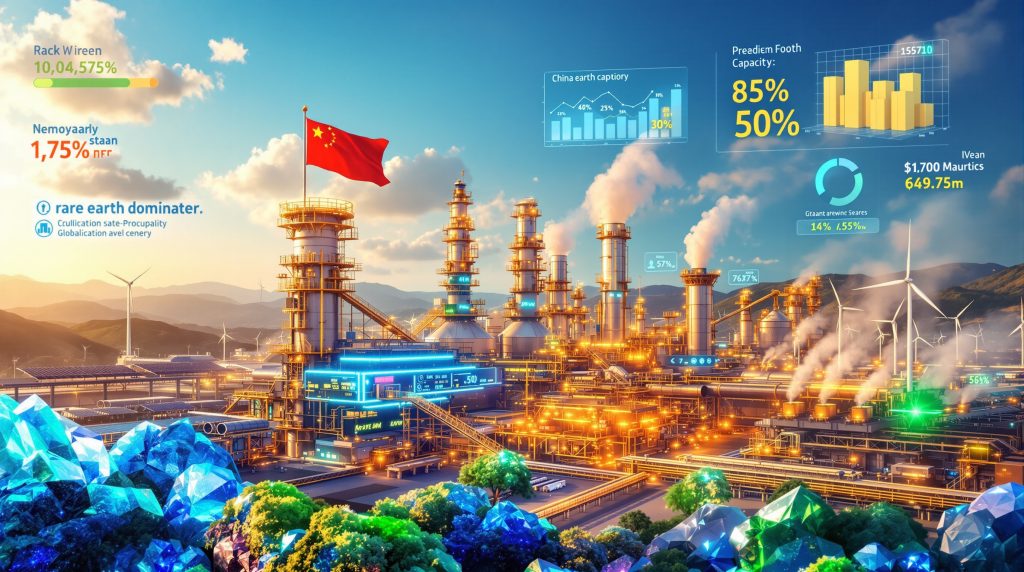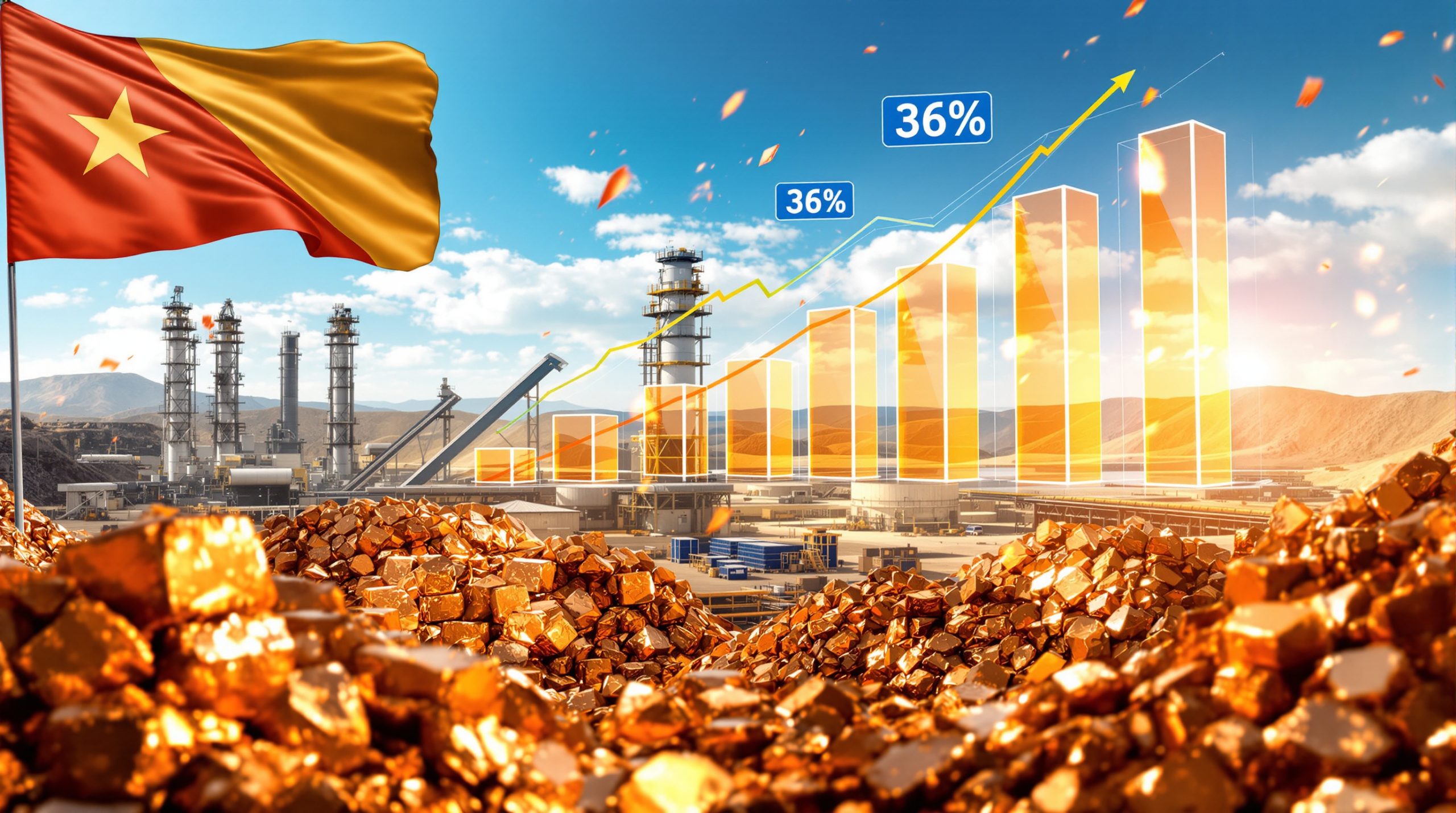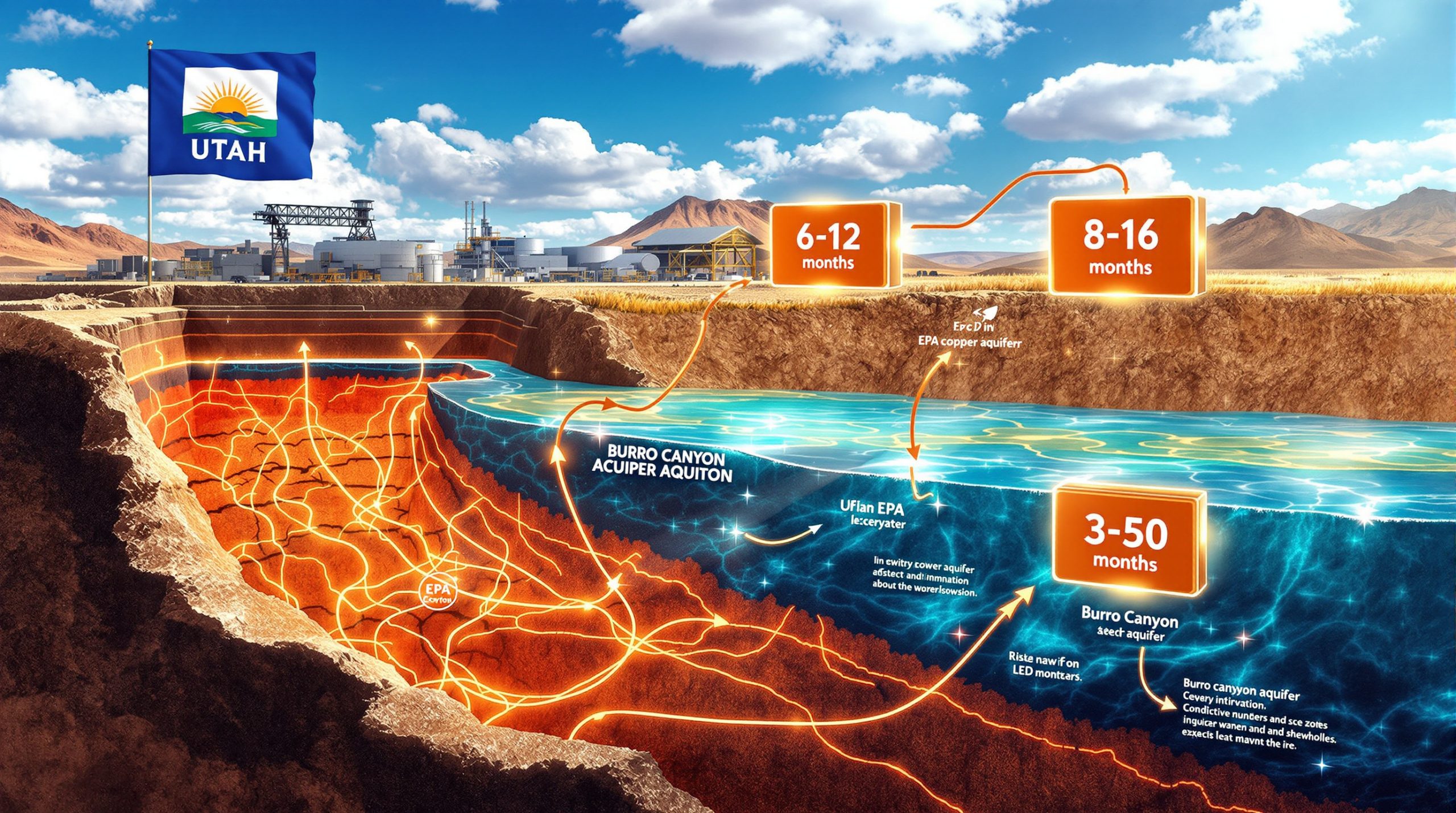The global rare earth industry has witnessed a fundamental transformation as Chinese enterprises evolve beyond basic mining operations into sophisticated processing powerhouses. Northern Rare Earth Group's subsidiary, known as Huamei Company, exemplifies this strategic shift through its comprehensive refining capabilities and technological advancement initiatives that are shaping the Huamei Refining Division global leadership in rare-earth industry.
This operational division has positioned itself within China's broader "Two Rare Earth Bases" national framework, representing a coordinated approach to dominating critical mineral supply chains. The integration extends beyond mere geographic concentration, encompassing technological development, environmental compliance, and market positioning strategies that collectively strengthen China's influence over global rare earth availability.
Geographic and Infrastructure Advantages
The refining division benefits from strategic positioning within China's established rare earth processing corridors, enabling efficient feedstock access and streamlined distribution networks. This geographic advantage reduces transportation costs and facilitates closer coordination with upstream mining operations and downstream manufacturers.
Infrastructure development has focused on creating vertically integrated processing capabilities that span the entire value chain from raw materials to refined products. Furthermore, the facility's design incorporates modern separation technologies, automated handling systems, and quality control mechanisms that ensure consistent output specifications.
Production Capacity and Technological Capabilities
Current operational capacity encompasses multiple rare earth elements with particular emphasis on light rare earth processing and separation. The facility maintains dedicated production lines for various oxide grades, meeting specifications required by electronics, automotive, and renewable energy applications.
Advanced separation technologies enable the division to process complex rare earth concentrates into individual element compounds with high purity levels. These capabilities have become increasingly important as downstream manufacturers demand more stringent quality standards for specialized applications, particularly in the context of critical minerals transition.
Phase II Green Smelting Technology Implementation
The transformation toward environmentally sustainable processing represents a critical evolution in China's rare earth industry approach. Traditional smelting operations have historically generated significant environmental impacts through energy consumption, waste production, and atmospheric emissions.
Environmental Impact Reduction Strategies
Modern green smelting implementations focus on multiple environmental improvement areas simultaneously:
• Energy Efficiency: Reduced thermal requirements through process optimisation
• Waste Minimisation: Circular processing loops that recycle intermediate materials
• Emission Control: Advanced filtration and treatment systems for atmospheric releases
• Water Management: Closed-loop water systems with comprehensive treatment protocols
The Phase II upgrade project specifically targets natural gas consumption reduction while maintaining production output levels. However, this dual objective requires sophisticated process engineering that balances thermal requirements with operational efficiency demands, aligning with broader sustainability transformation initiatives across the industry.
Product Quality Enhancement Through Advanced Processing
The shift toward high-purity rare earth compounds addresses a critical competitive gap that has traditionally favoured Western suppliers. Historical quality differences between Chinese and non-Chinese rare earth products have influenced purchasing decisions across multiple industrial sectors.
Recent technological improvements have narrowed these quality disparities significantly. Enhanced purification processes, improved contamination control, and rigorous quality assurance protocols now enable Chinese processors to compete directly with established Western suppliers on technical specifications.
Target applications for these enhanced products include:
• Electric Vehicle Motors: High-performance permanent magnet materials requiring exceptional purity
• Wind Turbine Generators: Large-scale magnetic systems with stringent reliability requirements
• Consumer Electronics: Miniaturised components demanding precise material properties
| Processing Parameter | Traditional Method | Green Smelting Approach | Performance Improvement |
|---|---|---|---|
| Energy Consumption | Standard thermal processing | Optimised temperature profiles | 15-20% reduction |
| Waste Generation | Linear processing model | Circular recovery systems | 35-45% reduction |
| Processing Time | Batch-based operations | Continuous flow systems | 20-25% improvement |
| Product Purity | Multi-stage purification | Integrated separation | 10-15% enhancement |
Digital Transformation and Operational Efficiency
The implementation of comprehensive digital systems represents a fundamental shift in rare earth processing operations. Traditional manufacturing approaches relied heavily on manual monitoring, periodic quality checks, and reactive maintenance protocols that often resulted in inefficiencies and inconsistent output quality.
Integrated Data Management Systems
The Digital 3.0 platform creates seamless information flow across all operational aspects, from raw material procurement through final product distribution. This integration enables real-time decision-making based on comprehensive data analysis rather than periodic reports or operator observations, reflecting broader digital mining innovation trends.
Key system components include:
• Production Monitoring: Continuous tracking of processing parameters and output quality
• Inventory Management: Automated tracking of raw materials, work-in-process, and finished goods
• Quality Control: Real-time analysis of product specifications and automated adjustment capabilities
• Maintenance Scheduling: Predictive maintenance protocols based on equipment performance data
Automated Systems Implementation
Physical automation complements digital monitoring through mechanical systems that reduce manual intervention requirements. Automated weighing systems ensure precise material handling while minimising contamination risks and improving consistency.
Automated Guided Vehicle (AGV) deployment eliminates manual material transport between processing stages. These systems operate continuously without breaks, reducing labour costs while improving safety conditions for human operators.
The continuous precipitation line retrofit specifically addresses praseodymium and neodymium processing, elements critical for permanent magnet applications. In addition, technical improvements in this area directly impact the cost competitiveness of Chinese rare earth products in global markets.
Cost Reduction Impact Analysis
Operational efficiency improvements translate directly into cost advantages that influence global market dynamics. Every processing cost reduction strengthens China's competitive position relative to alternative suppliers and increases pressure on non-Chinese rare earth companies.
The three-year lean management program establishes systematic approaches to identifying and eliminating operational inefficiencies. This structured methodology ensures continuous improvement rather than one-time cost reduction initiatives.
Dynamic supervision systems decompose cost reduction targets into specific operational objectives with clear accountability measures. Consequently, this approach creates organisational alignment around efficiency improvement goals while maintaining quality standards.
Research and Development Investment Strategy
Technological advancement through dedicated research and development activities distinguishes leading rare earth processors from commodity producers. The 4.33% research intensity represents a significant commitment to innovation relative to typical industrial manufacturing sectors.
Breakthrough Technology Development
Continuous multi-step extraction processes enable complete separation of rare earth elements from complex mineral concentrates. This capability eliminates the need for multiple processing facilities and reduces overall production costs while improving product purity.
The technology addresses a fundamental challenge in rare earth processing where traditional methods struggle to achieve complete element separation efficiently. Enhanced separation capabilities directly translate into higher-value product offerings and improved profit margins.
Circular Economy Integration
Resource recovery systems create closed-loop processing cycles that minimise waste generation while securing feedstock supplies. The ore processing to solution recovery approach specifically targets praseodymium and neodymium, elements with high market value and strong demand growth.
These circular systems reduce dependence on external raw material supplies while improving overall processing efficiency. Recovery operations often yield higher-purity materials than initial processing steps, creating quality advantages alongside cost benefits that support mine reclamation innovation.
Patent Development and Intellectual Property
Innovation pipeline development focuses on proprietary technologies that create sustainable competitive advantages. Patent protection for key processing methods prevents competitors from replicating technological advances without licensing agreements.
Research emphasis areas include:
• Separation Chemistry: Novel chemical processes for element isolation
• Process Engineering: Equipment design optimisation for efficiency improvement
• Environmental Technology: Waste reduction and emission control innovations
• Automation Systems: Smart factory integration and control algorithms
Environmental Compliance and Safety Standards
Regulatory compliance requirements have intensified significantly across China's industrial sectors, with rare earth processing facing particularly strict oversight due to historical environmental impacts. The transition to National Tier-2 safety standards reflects this regulatory evolution.
Comprehensive Risk Management Implementation
Modern safety protocols encompass all operational aspects from field operations through product distribution. This comprehensive approach addresses traditional safety concerns while incorporating emerging risks associated with advanced processing technologies.
Risk management systems include:
• Hazard Identification: Systematic assessment of all potential safety risks
• Prevention Protocols: Engineering controls and procedural safeguards
• Emergency Response: Comprehensive response procedures for various incident scenarios
• Continuous Monitoring: Real-time safety parameter tracking and alert systems
Three-Waste Governance Approach
Environmental management focuses on solid waste, liquid waste, and gaseous emission control through integrated treatment systems. This comprehensive approach addresses all environmental impact vectors simultaneously rather than treating each waste stream independently.
Solid waste management encompasses tailings handling, processing residue treatment, and byproduct recovery. Advanced separation techniques often enable valuable material recovery from waste streams that were previously considered disposal challenges.
Liquid waste treatment systems incorporate advanced purification technologies that enable water recycling while removing contaminants to acceptable discharge levels. Closed-loop water systems minimise fresh water consumption while reducing environmental discharge volumes.
Green Factory Certification Objectives
The autonomous green factory development timeline establishes measurable environmental performance targets with specific achievement deadlines. This certification process requires demonstration of sustainable operations across multiple performance criteria.
Green factory standards typically evaluate:
• Energy Efficiency: Power consumption per unit of production output
• Resource Utilisation: Raw material usage efficiency and waste minimisation
• Environmental Impact: Emission levels and ecological footprint assessment
• Sustainable Practices: Long-term viability of operational approaches
Global Supply Chain Dynamics and Market Control
China's dominance in rare earth processing creates significant implications for global supply chain structures and competitive dynamics. The concentration of processing capabilities within Chinese facilities establishes powerful leverage over international markets, particularly as China uses rare earth elements strategically to counter Western market positions.
Processing Capacity Concentration Effects
Current global processing capacity distribution heavily favours Chinese operations, with limited alternative sources available for most rare earth products. This concentration creates dependency relationships that influence international trade patterns and strategic planning decisions.
Western manufacturers often lack access to alternative processing sources, particularly for heavy rare earth elements where Chinese facilities control nearly all global capacity. This dependency extends beyond simple supply availability to encompass quality specifications, delivery schedules, and pricing structures.
Competitive Pressure on International Suppliers
Cost structure advantages from operational efficiency improvements create sustained competitive pressure on non-Chinese rare earth suppliers. Traditional Western advantages in technology and quality are diminishing as Chinese processors implement advanced systems and quality control measures.
Margin compression effects ripple throughout the global supply chain as Chinese suppliers offer competitive pricing while maintaining acceptable quality levels. This pricing pressure forces international competitors to reduce costs or exit market segments where they cannot achieve competitive positioning.
Supply Chain Resilience Challenges
Dependency on Chinese processing creates strategic vulnerabilities for countries and companies seeking supply chain diversification. Alternative processing development requires significant capital investment and technological development over extended timeframes.
The concentration of rare earth processing capabilities within China represents more than industrial efficiency; it creates strategic dependencies that influence international relations, trade policies, and national security considerations across multiple countries and regions.
| Processing Stage | Chinese Market Share | Alternative Sources | Development Timeline |
|---|---|---|---|
| Light Rare Earth Separation | 85-90% | Australia, Malaysia | 3-5 years |
| Heavy Rare Earth Processing | 95-98% | Limited pilot projects | 5-8 years |
| High-Purity Compounds | 75-80% | Japan, Estonia | 2-4 years |
| Specialty Alloys | 60-70% | USA, Germany | 1-3 years |
Investment Implications and Market Opportunities
The transformation of China's rare earth processing capabilities creates both challenges and opportunities for international investors and companies. Understanding these dynamics becomes crucial for strategic planning and investment decision-making.
Upstream Mining Investment Considerations
Alternative supply chain development requires substantial upstream mining investments outside China. Several publicly traded companies on the Australian Securities Exchange (ASX) represent potential opportunities for investors seeking exposure to non-Chinese rare earth development.
Geographic diversification efforts focus on regions with established mining capabilities and favourable regulatory environments. Australia, Canada, and selected African countries offer potential development opportunities, though each faces unique technical and economic challenges.
Resource quality analysis becomes critical when evaluating alternative supply sources. Ore grades, processing requirements, and infrastructure availability significantly influence project economics and development timelines.
Technology Sector Investment Opportunities
Processing equipment manufacturers benefit from global demand for advanced separation and refining technologies. Companies developing innovative processing methods or environmental technology solutions may find expanding markets as alternative suppliers seek technological advantages.
Automation and digitalisation solution providers serve growing demand from rare earth processors seeking operational efficiency improvements. These technology applications extend beyond rare earth processing to encompass broader mining innovation trends across multiple industrial manufacturing sectors.
Environmental technology specialists address increasing regulatory requirements and sustainability objectives across the global rare earth industry. Advanced waste treatment, emission control, and resource recovery technologies represent expanding market opportunities.
Strategic Considerations for International Investors
Investment strategies must account for geopolitical risks, regulatory changes, and technological developments that influence rare earth market dynamics. Long-term investment horizons often prove necessary due to extended development timelines and capital requirements.
Portfolio diversification across multiple supply chain segments may reduce concentration risks while providing exposure to various growth opportunities. Balanced approaches often combine upstream mining, midstream processing, and downstream application investments.
Furthermore, recent developments show that Huamei's refining division is powering up with specific targets for achieving global leadership in the rare-earth industry, making it a key focus for strategic planning.
Disclaimer: This analysis is provided for informational purposes only and should not be construed as investment advice. Rare earth investments carry significant risks including commodity price volatility, regulatory changes, and geopolitical factors. Investors should conduct thorough due diligence and consult qualified financial advisors before making investment decisions.
Future Outlook for Global Rare Earth Processing
The trajectory of global rare earth processing appears increasingly influenced by Chinese technological advancement and operational efficiency improvements. Traditional competitive advantages held by Western suppliers continue to erode as Chinese facilities implement sophisticated processing technologies and quality control systems.
Production Capacity Expansion Projections
Planned facility upgrades and new project developments indicate continued expansion of Chinese processing capabilities. These capacity additions will likely strengthen China's market position while creating additional competitive pressure on alternative suppliers.
Expected output increases from modernisation projects may outpace global demand growth in certain market segments, potentially creating oversupply conditions that favour buyers over suppliers. This dynamic could further compress margins for all suppliers while benefiting downstream manufacturers.
The timeline for achieving autonomous green factory status represents a significant milestone in sustainable processing development. Success in this area may establish new industry standards that create additional barriers for competing facilities lacking similar environmental capabilities.
Technology Evolution and Competitive Positioning
Continuous innovation in separation and processing technologies may eliminate remaining quality gaps between Chinese and Western suppliers. This technological convergence reduces product differentiation opportunities while intensifying price-based competition.
Advanced automation and digital control systems implementation across Chinese facilities creates operational efficiency advantages that may prove difficult for competitors to match without similar capital investments. These technological improvements compound over time, creating sustainable cost advantages.
Patent development in critical processing technologies may create intellectual property barriers that limit alternative supplier development options. Consequently, proprietary technology licensing could become necessary for competitive processing facility development outside China.
Long-term Market Structure Implications
The shrinking window for non-Chinese technological arbitrage opportunities suggests limited timeframes for alternative supplier development. Companies and countries seeking supply chain diversification may face increasingly challenging economics as Chinese suppliers continue improving their capabilities.
Innovation requirements for maintaining market relevance continue escalating as Chinese processors invest heavily in research and development activities. Competitive positioning increasingly depends on technological advancement rather than established market relationships or geographic advantages.
The evolution of China's rare earth processing capabilities represents a fundamental shift in global supply chain dynamics that extends far beyond commodity markets to encompass strategic materials essential for modern technology and clean energy infrastructure.
Strategic Implications for Global Stakeholders
Understanding the implications of Huamei Refining Division global leadership in rare-earth industry requires comprehensive analysis of competitive positioning, supply chain risks, and strategic response options available to various stakeholders.
Key Considerations for Industry Participants
The technological advancement and operational efficiency improvements demonstrated by Chinese rare earth processors create new competitive realities that affect all supply chain participants. Traditional competitive advantages based on technology gaps or quality differences may no longer provide sustainable positioning.
Supply chain diversification strategies become increasingly complex as alternative processing sources remain limited while Chinese capabilities continue expanding. Strategic planning must account for extended development timelines and substantial capital requirements associated with alternative supplier development.
Market participants must evaluate whether competitive positioning depends on challenging Chinese suppliers directly or focusing on specialised applications and niche markets where technical expertise and customer relationships may provide sustainable advantages.
Strategic Response Framework
Successful navigation of evolving rare earth market dynamics requires clear understanding of competitive positioning relative to Chinese suppliers and realistic assessment of available strategic options.
Specialisation Strategy:
• Focus on high-value specialty applications requiring unique technical expertise
• Develop proprietary processing methods for specific customer requirements
• Build strong customer relationships in niche market segments
• Invest in application development and technical support capabilities
Technology Innovation Approach:
• Develop alternative processing technologies that offer distinct advantages
• Focus on environmental sustainability and regulatory compliance innovations
• Create intellectual property portfolios in emerging technology areas
• Establish research partnerships with academic institutions and technology companies
Strategic Partnership Development:
• Build collaborative relationships across the value chain
• Develop joint ventures with complementary capabilities
• Create strategic alliances for technology sharing and market access
• Establish long-term supply agreements with key customers
The transformation of China's rare earth processing capabilities through companies like Huamei Refining Division global leadership in rare-earth industry represents more than industrial development; it signifies a fundamental restructuring of global supply chains that affects strategic planning across multiple industries and countries. Success in this evolving environment requires clear understanding of competitive dynamics, realistic assessment of available options, and strategic commitment to sustainable competitive positioning approaches.
Are You Tracking Australia's Next Major Mineral Discovery?
Discovery Alert's proprietary Discovery IQ model instantly identifies significant ASX mineral discoveries, including critical minerals that power global rare earth supply chains and renewable energy infrastructure. With Chinese dominance reshaping global rare earth markets, Australian companies developing alternative processing capabilities represent compelling investment opportunities that our AI-powered alerts help subscribers identify before the broader market. Begin your 30-day free trial today to position yourself ahead of these transformative discoveries.




